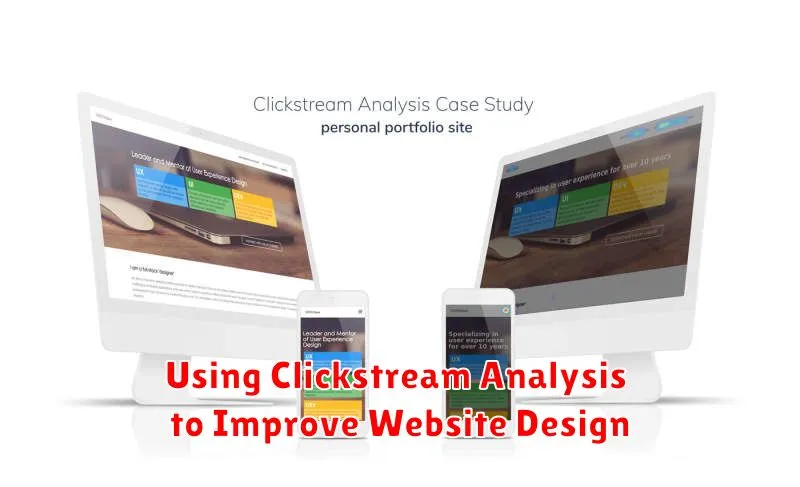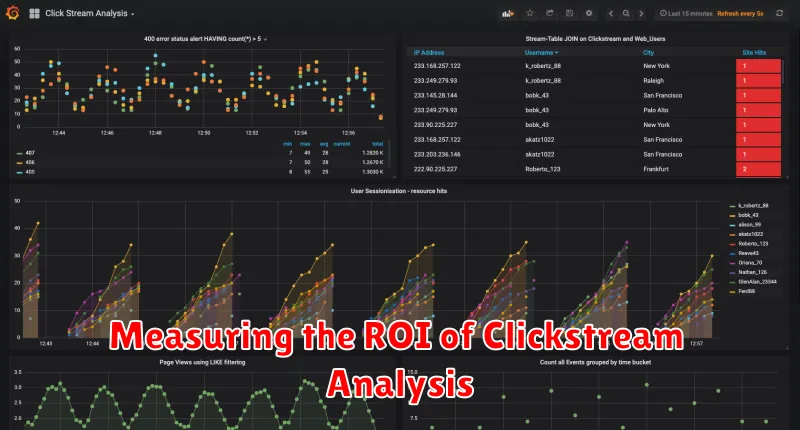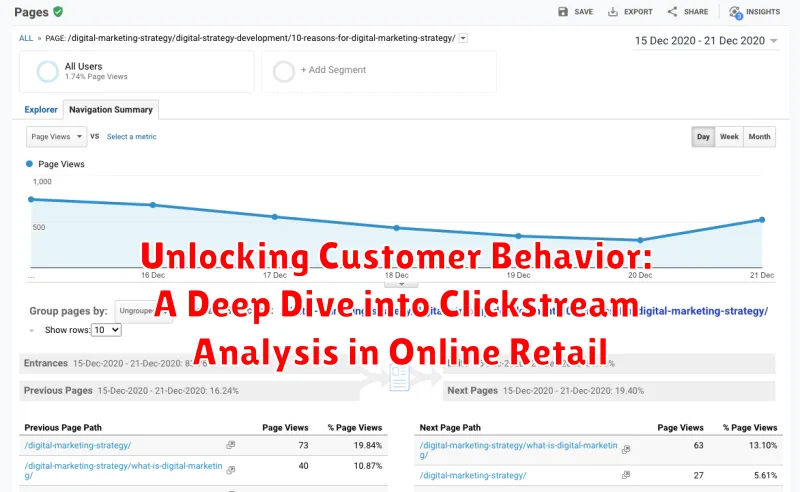In today’s fiercely competitive online retail landscape, understanding customer behavior is paramount to success. Clickstream analysis offers a powerful lens through which businesses can decipher the complex digital journeys of their customers. This in-depth exploration will delve into the mechanics of clickstream analysis, revealing how online retailers can leverage this valuable data to optimize their websites, personalize the customer experience, and ultimately, drive conversions and boost revenue. From the initial website visit to the final purchase (and beyond), understanding the intricacies of customer behavior is key to unlocking sustainable growth in the digital marketplace. We will explore the significance of clickstream data in illuminating the customer journey and how this knowledge translates into actionable insights.
This article will provide a comprehensive guide to clickstream analysis in online retail, covering key aspects such as data collection, analysis techniques, and practical applications. We will examine how clickstream data can be harnessed to personalize product recommendations, optimize website navigation, and enhance the overall customer experience. Furthermore, we’ll explore advanced applications of clickstream analysis, including predictive modeling and customer segmentation, empowering businesses to anticipate future customer behavior and tailor their strategies accordingly. By understanding the power of clickstream analysis, online retailers can gain a competitive edge, optimize their online presence, and achieve sustainable growth in the ever-evolving digital landscape. Join us as we unlock the secrets to understanding customer behavior through the insightful lens of clickstream analysis.
What is Clickstream Analysis and Why is it Important?
Clickstream analysis is the process of collecting, analyzing, and reporting aggregate data about which pages a website visitor visits, and in what order. It provides valuable insights into user behavior online, revealing how customers interact with a website.
This data is crucial for understanding customer journeys, identifying pain points, and optimizing the user experience. By examining clickstream data, businesses can uncover patterns in browsing behavior, such as common navigation paths, drop-off points, and popular product categories. This understanding is essential for making informed decisions about website design, marketing strategies, and product development.
The importance of clickstream analysis stems from its ability to transform raw data into actionable insights. It allows businesses to move beyond simple page view metrics and delve into the “why” behind customer actions. Ultimately, clickstream analysis empowers businesses to create more engaging and effective online experiences, leading to increased conversions and customer satisfaction.
How Clickstream Data is Collected and Analyzed
Clickstream data collection relies heavily on website server logs and utilizes various technologies to track user interactions. Cookies play a crucial role, storing information about user preferences and browsing history. JavaScript tagging allows for real-time tracking of actions like clicks, mouse movements, and page scrolls. Other methods include web beacons and log file analysis.
The analysis phase involves processing this raw data into meaningful insights. Data is typically aggregated and segmented to identify patterns and trends. Statistical analysis helps quantify user behavior, while data mining techniques uncover hidden relationships. Sophisticated tools and algorithms are used to visualize data and generate reports that inform business decisions.
Key Metrics in Clickstream Analysis
Several key metrics provide valuable insights into user behavior on e-commerce websites. Understanding these metrics is crucial for optimizing the online shopping experience and driving sales.
Click-Through Rate (CTR) measures the percentage of users who click on a specific link or element. A high CTR indicates effective calls to action and engaging content.
Conversion Rate tracks the percentage of visitors who complete a desired action, such as making a purchase or signing up for a newsletter. This metric reflects the effectiveness of the sales funnel.
Bounce Rate represents the percentage of visitors who leave a website after viewing only one page. A high bounce rate can signal issues with website design, content relevance, or user experience.
Average Session Duration indicates the average time users spend on a website. Longer session durations suggest higher engagement and interest in the content.
Pages per Visit measures the average number of pages viewed by a user during a single session. This metric helps assess website navigation and content exploration.
Understanding Customer Behavior with Clickstream Data
Clickstream analysis provides invaluable insights into how customers interact with an online retail environment. By examining the sequence of clicks, we can uncover hidden patterns and preferences that drive purchasing decisions. This data allows businesses to move beyond basic demographics and delve into actual online behavior.
Segmentation becomes more powerful with clickstream data. Instead of relying solely on declared preferences, we can group customers based on their actual browsing habits. Do they favor specific product categories? How much time do they spend on certain pages? These questions can be answered and used to tailor marketing efforts.
Predictive analysis is another key benefit. By recognizing patterns in navigation, we can anticipate future actions. This allows for personalized product recommendations, targeted promotions, and even proactive customer service intervention. Ultimately, understanding customer behavior through clickstream analysis allows businesses to optimize the user experience, increasing conversion rates and building customer loyalty.
Using Clickstream Analysis to Improve Website Design

Clickstream analysis provides invaluable data for optimizing website design and enhancing user experience. By understanding how customers navigate your site, you can identify areas for improvement and create a more seamless and engaging online journey. Analyzing click paths reveals pain points, such as high bounce rates on specific pages or unexpected drop-offs during the checkout process. This information allows for targeted design changes to address these issues.
For instance, if clickstream data reveals that users frequently abandon their carts after viewing the shipping costs page, you might consider redesigning that page to present the information more clearly or offering alternative shipping options. Similarly, if users struggle to find specific products, improving the site’s search functionality or navigation menu could significantly improve their experience. By leveraging clickstream data, businesses can create a more intuitive and user-friendly website design that drives conversions and customer satisfaction.
A/B testing is a powerful tool to use in conjunction with clickstream analysis. By testing different versions of web pages, you can determine which design elements resonate most effectively with your target audience. Analyzing the clickstream data from these tests helps pinpoint which version drives more conversions and improves key metrics like time spent on page and click-through rates. This data-driven approach to website design ensures that changes are based on actual customer behavior, leading to more impactful improvements.
Optimizing Product Placement and Recommendations
Clickstream analysis provides invaluable insights into how customers navigate an online store, allowing retailers to strategically optimize product placement for maximum impact. By analyzing browsing patterns, retailers can identify which products are frequently viewed together and adjust their online store layout accordingly. Placement of related items near popular products can encourage additional purchases and increase average order value.
Product recommendation engines are significantly enhanced by clickstream data. Analyzing the sequence of clicks reveals hidden customer preferences and purchase intent. This data can be used to generate personalized product recommendations, increasing conversion rates and customer satisfaction. By understanding the customer’s journey, retailers can offer relevant suggestions, promoting cross-selling and upselling opportunities.
A/B testing different product placements and recommendation strategies, informed by clickstream data, allows retailers to continuously refine their approach and maximize effectiveness. Tracking the impact of changes on key metrics such as click-through rates, conversion rates, and average order value ensures optimization efforts are data-driven and yield measurable results.
Personalizing the Customer Journey with Clickstream Insights
Clickstream analysis empowers businesses to create truly personalized customer journeys. By understanding individual browsing patterns, preferences, and purchase history, retailers can tailor every interaction to resonate with each shopper.
Targeted product recommendations are a key aspect of personalization. If a customer consistently views running shoes, the website can dynamically display relevant accessories like socks or hydration packs. This increases the likelihood of additional purchases and enhances the customer experience.
Personalized promotions can also be delivered based on clickstream data. For instance, if a shopper abandons a cart containing a specific item, a tailored email offering a discount on that product can be automatically triggered. This proactive approach can recapture lost sales and foster customer loyalty.
Furthermore, clickstream analysis enables customized website navigation. Frequently accessed sections can be highlighted for individual users, streamlining their browsing experience and making it easier to find what they need.
Enhancing Marketing Campaigns with Clickstream Data
Clickstream analysis provides invaluable data for refining and targeting marketing campaigns. By understanding how customers interact with your website, you can optimize your campaigns for maximum impact.
Targeted Advertising: Analyzing clickstream data reveals which products and categories resonate with specific customer segments. This allows for the creation of highly targeted ads, delivered to the right audience at the right time, increasing conversion rates.
Personalized Messaging: Craft compelling marketing messages tailored to individual customer preferences. Knowing the pages a customer visits, products they view, and searches they perform allows for personalized email campaigns and on-site promotions that resonate more effectively.
Campaign Performance Measurement: Clickstream analysis offers real-time insights into campaign effectiveness. Track which marketing channels are driving traffic and conversions, enabling data-driven decisions for budget allocation and campaign optimization.
A/B Testing and Optimization: Leverage clickstream data to conduct A/B testing on various marketing elements, such as landing pages, ad copy, and call-to-actions. Identify what resonates best with your target audience and continuously refine your campaigns for optimal performance.
Measuring the ROI of Clickstream Analysis

Demonstrating the return on investment (ROI) of clickstream analysis is crucial for justifying its continued use and securing further investment. Key Performance Indicators (KPIs) should be established upfront, aligned with business objectives. These might include conversion rates, average order value, customer lifetime value, and cart abandonment rates.
By comparing these metrics before and after implementing changes based on clickstream data, businesses can quantify the impact of their optimization efforts. For instance, a reduction in cart abandonment rates directly translates to increased revenue. Similarly, improvements in product recommendations leading to higher average order values offer a clear ROI.
Tracking the cost of implementing and maintaining clickstream analysis tools and personnel is also essential. By weighing these costs against the financial gains achieved through data-driven optimizations, a concrete ROI can be calculated. This data-driven approach enables businesses to demonstrate the value of clickstream analysis and justify continued investment in this valuable technology.

